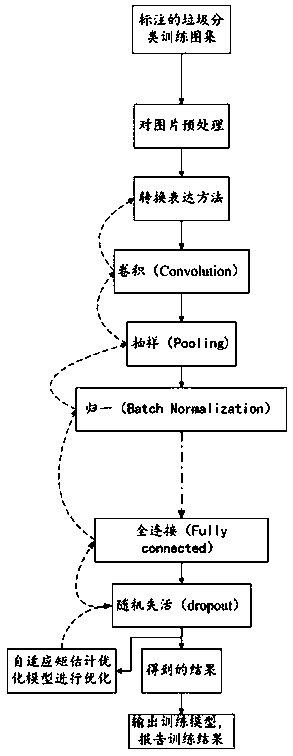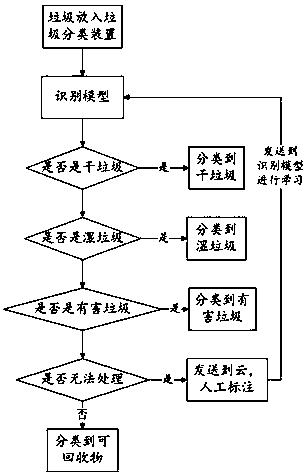Method for realizing automatic garbage classification
A technology of automatic classification and garbage classification, applied in the direction of neural learning methods, instruments, biological neural network models, etc., can solve the problems of high labor cost, low efficiency, easy to cause errors, etc., and achieve the effect of enhancing recognition ability
- Summary
- Abstract
- Description
- Claims
- Application Information
AI Technical Summary
Problems solved by technology
Method used
Image
Examples
Embodiment 1
[0044] A method for realizing automatic classification of garbage, including a model training process, a garbage classification method based on the model training process, such as figure 1 As shown, the model training process includes the following steps in sequence:
[0045] S1: Put the marked garbage classification training atlas into the model preprocessor for preprocessing. The preprocessing is to increase the recognition ability of the model (Robustness);
[0046] S2: Input the preprocessed RGB three-channel image into the deep neural network. Generally speaking, the image will be converted into an expression method;
[0047] S3: In the first convolutional layer (Convolution Layer) of the deep neural network, use Zero Padding to fill the gap between the filter size (filter) and the image size;
[0048] S4: In the second sampling layer of the deep neural network, feature extraction is performed on the features obtained after the convolutional layer is extracted, so as to ...
Embodiment 2
[0057] Such as figure 2 As shown, the garbage classification method based on the model training and identification process includes the following steps in sequence:
[0058] T1: At least based on the three usage characteristics of garbage types, size characteristics and user dumping habits, a two-class (Two class classification) recognition model is trained for each two types of garbage. In the garbage classification method based on the model training process, It is to classify the garbage categories to be divided into two categories (Two class classification) in turn, and finally divide the garbage into each category;
[0059] T2: Train several two-category recognition models according to requirements to assist garbage sorting devices. Generally speaking, garbage can be divided into dry garbage, wet garbage, recyclables and hazardous garbage according to current Chinese requirements. For this situation, it can be set as Three two-class (Two class classification) recognition...
Embodiment 3
[0064] This embodiment is a further description of embodiment 2, as figure 2 , image 3 As shown, the model training process also includes a model evolution step, and the model evolution step is set such that when the recognition model encounters a photo that cannot be processed, the garbage sorting device sends the picture to the cloud through the network card, and after manual labeling , re-input into the model training process as supplementary data for learning. The photos that cannot be processed include, but are not limited to, junk images that cannot be identified by the model, or incorrectly classified images submitted manually, or images that are recognized correctly but whose recognition confidence is lower than a preset certain threshold.
[0065] The garbage classification method based on the model training and recognition process uses the two-class recognition model to ensure that only one class of features is recognized for each classification, which greatly imp...
PUM
 Login to View More
Login to View More Abstract
Description
Claims
Application Information
 Login to View More
Login to View More - R&D
- Intellectual Property
- Life Sciences
- Materials
- Tech Scout
- Unparalleled Data Quality
- Higher Quality Content
- 60% Fewer Hallucinations
Browse by: Latest US Patents, China's latest patents, Technical Efficacy Thesaurus, Application Domain, Technology Topic, Popular Technical Reports.
© 2025 PatSnap. All rights reserved.Legal|Privacy policy|Modern Slavery Act Transparency Statement|Sitemap|About US| Contact US: help@patsnap.com



